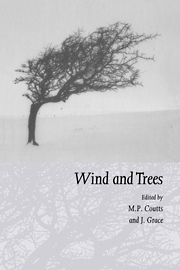Book contents
- Frontmatter
- Contents
- Preface
- List of contributors
- Part I Airflow over topography and in forests
- Part II Mechanics of trees under wind loading
- 7 Understanding wind forces on trees
- 8 Modelling mechanical stresses in living Sitka spruce stems
- 9 Experimental analysis and mechanical modelling of windinduced tree sways
- 10 Failure modes of trees and related failure criteria
- 11 An experimental investigation of the effects of dynamic loading on coniferous trees planted on wet mineral soils
- 12 Measurement of wind-induced tree-root stresses in New Zealand
- 13 New methods for the assessment of wood quality in standing trees
- Part III Tree physiological responses
- Part IV Impacts of wind on forests and ecology
- Part V Risk assessment and management response
- Index
13 - New methods for the assessment of wood quality in standing trees
Published online by Cambridge University Press: 27 October 2009
- Frontmatter
- Contents
- Preface
- List of contributors
- Part I Airflow over topography and in forests
- Part II Mechanics of trees under wind loading
- 7 Understanding wind forces on trees
- 8 Modelling mechanical stresses in living Sitka spruce stems
- 9 Experimental analysis and mechanical modelling of windinduced tree sways
- 10 Failure modes of trees and related failure criteria
- 11 An experimental investigation of the effects of dynamic loading on coniferous trees planted on wet mineral soils
- 12 Measurement of wind-induced tree-root stresses in New Zealand
- 13 New methods for the assessment of wood quality in standing trees
- Part III Tree physiological responses
- Part IV Impacts of wind on forests and ecology
- Part V Risk assessment and management response
- Index
Summary
Abstract
Two instruments are described for assessing the trunks of standing trees for defects which affect their strength. One, the Metriguard Stress Wave Timer, measures the time taken for a sound wave to travel through the trunk; defects reduce the velocity of the wave. The other, called the Fractometer, measures the stiffness, strength and static fracture energy of a core removed with an increment borer.
Introduction
Two devices for the assessment of wood quality in standing trees are described. The first is a modification and an adaptation of an existing device, namely a Metriguard Stress Wave Timer, and the second is a new tool for measuring the strength of core samples. These two devices support a method of assessment known as Visual Tree Assessment (VTA) which was developed at the Karlsruhe Nuclear Research Centre (Mattheck & Breloer, 1993). VTA is based on the observation that a tree which contains a defect (crack, hollow, etc.) will repair itself by attachment of more wood at the weakened cross-section in order to restore the state of even load distribution (Mattheck, 1991). Figure 13.1 shows some typical symptoms and related defects. If these symptoms are visible in trees that could pose a hazard to the safety of the public, further investigation is justified. Also, in commercial forestry it may be necessary to check the wood quality of a stand as the basis of management decisions. This requires an assessment of the size of the internal defect, and a measure of the strength of the affected wood – tasks that can be achieved with the devices described below.
- Type
- Chapter
- Information
- Wind and Trees , pp. 227 - 234Publisher: Cambridge University PressPrint publication year: 1995



